
Melaleuca viminalis, commonly known as weeping bottlebrush or creek bottlebrush, is a plant in the myrtle family Myrtaceae, and is endemic to New South Wales, Queensland and Western Australia. It is a multi-trunked, large shrub or tree with hard bark, often pendulous foliage and large numbers of bright red bottlebrush flowers in spring and summer. It is possibly the most commonly cultivated melaleuca in gardens and its cultivars are often grown in many countries.

Melaleuca lanceolata commonly known as black paperbark, moonah, Rottnest Island teatree and western black tea tree is a plant in the myrtle family, Myrtaceae and is native to Australia where it occurs in Western Australia, South Australia, Victoria, New South Wales and Queensland. It is a densely foliaged tree with rough bark, which flowers prolifically in summer.
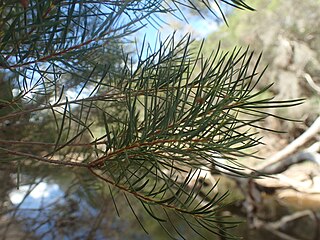
Melaleuca trichostachya is a plant in the myrtle family, Myrtaceae and is native to inland northern New South Wales, Queensland, South Australia and the Northern Territory in Australia. It is a small tree, similar to the commonly cultivated Melaleuca styphelioides, with its prickly foliage and fluffy spikes of white or cream flowers but there are differences in the leaf arrangement and fruiting capsules.
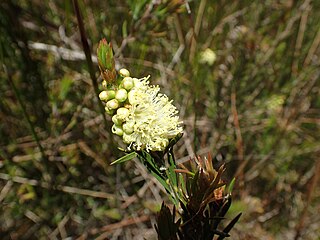
Melaleuca paludicola, commonly known as river bottlebrush, is a plant in the myrtle family Myrtaceae, and is endemic to eastern Australia. It is a shrub or small tree with flexible, often drooping branches, pinkish new growth and spikes of cream, pale yellow, or sometimes pink flowers in summer.
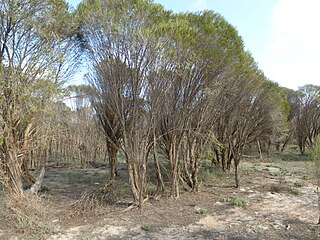
Melaleuca atroviridis is a plant in the myrtle family, Myrtaceae and is endemic to the south-west of Western Australia. It was formerly included in the species Melaleuca uncinata but a review of that species lead to the identification of a number of new species. Like M. uncinata, this species is used for the production of brushwood fencing. It has fewer stamens in the flowers and somewhat smaller clusters of fruit but has the same needle-like leaves with a hooked end and spikes of creamy yellow flowers in early summer.
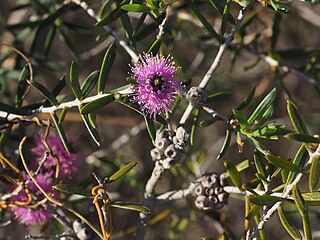
Melaleuca caeca is a plant in the myrtle family, Myrtaceae and is endemic to the south-west of Western Australia. It is similar to a number of other Western Australian melaleucas such as M. pentagona with its purple pom-pom flower heads but it is a smaller shrub with narrower leaves and smaller inflorescences.

Melaleuca squamophloia is a plant in the myrtle family, Myrtaceae and is endemic to the black soil plains of south eastern Queensland in Australia. Like its close relative Melaleuca styphelioides, it is a small, erect tree with prickly leaves and spikes of cream or white flowers but its bark is hard rather than papery and the leaves have fewer veins than that species.
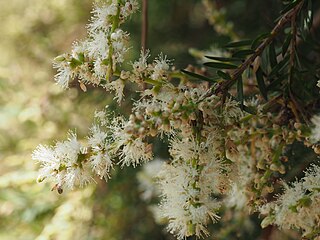
Melaleuca decora, commonly known as the white feather honeymyrtle, is a plant in the myrtle family, Myrtaceae and is native to eastern Australia. It is a large shrub to small tree with papery bark, lance-shaped leaves and sweet-smelling, creamy-coloured flowers in summer. It grows in near-coastal forest and swamps in New South Wales and Queensland.

Melaleuca nodosa, commonly known as the prickly-leaved paperbark, is a plant in the myrtle family Myrtaceae, and is endemic to eastern Australia. It is a shrub or small tree with narrow, sometimes needle-like leaves and profuse heads of yellow flowers as early as April or as late as January.

Melaleuca biconvexa is a tree or shrub in the myrtle family, Myrtaceae and is endemic to coastal areas of New South Wales. The leaves have a distinctive, wing-like shape and the flowers are in white or cream-coloured heads at the ends of its branches. It is classified as a vulnerable species.

Melaleuca cornucopiae is a shrub in the myrtle family Myrtaceae and is endemic to western Arnhem Land in the Northern Territory of Australia. It is distinguished by it unusual flowering spike - a horn-like structure covered by overlapping bracts with the flowers opening in succession, starting from the bottom of the spike.

Melaleuca diosmatifolia, commonly known as rosy paperbark and pink honey-myrtle is a plant in the myrtle family, Myrtaceae and is native to Queensland and New South Wales in Australia. It was formerly known as Melaleuca erubescens but is not closely related to Melaleuca diosmifolia although the species name has the same meaning. It has pointed, non-prickly leaves and cylindrical spikes of pink or purple flowers.

Melaleuca groveana, commonly known as Grove's paperbark is a plant in the myrtle family Myrtaceae and is endemic to New South Wales and Queensland in Australia. It is an uncommon species with relatively large heads of white flowers in spring, the styles of which are significantly longer than the stamens.
Melaleuca kunzeoides is a shrub in the myrtle family Myrtaceae and is endemic to central Queensland in Australia. It is a rare shrub with a very limited distribution and is classified as 'vulnerable' by the Australian Government.

Melaleuca pallescens is a plant in the myrtle family, Myrtaceae, and is endemic to the state of Queensland in Australia. It has hard, furrowed bark and very small leaves that have the lower part of their upper surface pressed against the branches of the plant.

Melaleuca parvistaminea is a plant in the myrtle family, Myrtaceae, and is endemic to the states of New South Wales and Victoria in Australia. It has hard, rough bark, cream coloured flowers and leaves in whorls of three around the stems.

Melaleuca pomphostoma is a plant in the myrtle family, Myrtaceae, and is endemic to the south-west of Western Australia. It is a small, dense shrub with fleshy, narrow leaves, greenish-yellow flowers. It is similar and closely related to Melaleuca bracteosa but differs in the colour and number of stamens in each flower.

Melaleuca punicea is a plant in the myrtle family, Myrtaceae, and is endemic to the Northern Territory in Australia. Some of the characteristics of this species make it difficult to classify at the genus level. After it was originally described in 1984 as Melaleuca punicea, it was transferred in 1986 to the genus Regelia but it did not fit well in that genus either. In 1999 it was transferred again to a new genus Petraeomyrtus as P. punicea. Subsequent molecular studies, especially of chloroplast DNA have suggested that it is best placed in Melaleuca along with others from genera including Beaufortia, Callistemon and Regelia. Later publications include this species as Melaleuca punicea.
Melaleuca sericea is a plant in the myrtle family, Myrtaceae, and is endemic to the north of Western Australia and the north-west of the Northern Territory. It is a paperbark similar to Melaleuca dealbata but its leaves are covered with silky hairs, the flowers are whitish by comparison and it does not grow as tall as that species.

Melaleuca tortifolia is a plant in the myrtle family, Myrtaceae and is endemic to a small area on the Northern Tablelands of New South Wales in Australia. It has egg-shaped, twisted leaves and heads, or short spikes of white or creamy-white flowers in December. It is classified as a threatened species.

















